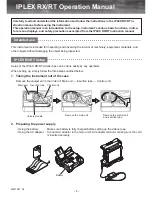
RUSKA 2465A-754
Users Manual
5-10
The High Range Piston and Cylinder can be installed as follows.
1.
The Filter, Filter Retainer, and O-Ring should be in the gauge, as they were in
Chapter 5, General.
2.
Next, insert the Cylinder Container (2460-6-1) and the piston and cylinder after they
have been cleaned in accordance with the cleaning instructions in Chapter 6,
Piston/Cylinder Cleaning Instructions, being certain that the O-Ring (54-703-113) is
inserted in the Cylinder Container.
3.
The O-Ring should be lubricated with DuPont Krytox 240 AA Grease (45-339)
before installation. All excess lubricant should be wiped off, leaving only a slight
film.
4.
Place the Cylinder Retainer (2460-6-2) over the cylinder.
5.
Insert the Hex Wrench (94-608) into the hole in the side of the housing.
6.
Place the Retaining Cap (2460-4-7) onto the cylinder housing.
7.
Tighten the cap securely by hand.
The gauge is now ready for operation.
When working at high pressures (over 100 psi), or after reducing a high pressure to a
lower pressure, the high range piston can sometimes seem sticky even if it is clean.
Rotating the cylinder with the motor while gently bouncing the weights up and down
usually frees the piston in a minute or so. However, if the piston is actually dirty, no
amount of rotating or bouncing will make it perform properly. In that case the piston and
cylinder must be cleaned.
Establishing Gauge Pressures
Gauge Pressures
Pressure should be admitted slowly into the gauge, preferably through a metering valve.
It is very convenient to have a pressure adjusting pump such as RUSKA 2465A-800
Manual Pressure Controller to adjust the system pressure. When the piston is floating
(suspended on a gas cushion between piston stops) and not oscillating and the system is
at equilibrium, a reading may be taken.
When there are enough weights on the piston, the weights can be rotated slowly by hand
opposite of the rotation of the cylinder. The weights will rotate against the cylinder
rotation for sometime before they begin to rotate with the cylinder. When the weights
begin to rotate with the cylinder, they can again be rotated by hand in the opposite
direction. This allows the operator to observe any irregularities in the motion of the
piston. For example, if the piston and weights quickly begin to rotate with the cylinder, a
dirty piston and cylinder is indicated. Chapter 6 of this manual, Piston/Cylinder Cleaning
Instructions, includes detailed information for piston cleanliness checks. It is suggested
that the motor be used only when necessary. After the weights have acquired some
momentum, the motor may be turned off and the weights permitted to continue their
rotation. With this practice, the piston is less likely to be operated when dirty and there
will be less heat generated in the instrument from that dissipated by the motor.
Summary of Contents for RUSKA 2465A-754
Page 5: ...iii List of Tables Table Title Page 2 1 Symbols 2 2 ...
Page 6: ...RUSKA 2465A 754 Users Manual iv ...
Page 8: ...RUSKA 2465A 754 Users Manual vi ...
Page 12: ...RUSKA 2465A 754 Users Manual 1 4 ...
Page 26: ...RUSKA 2456A 754 Users Manual 3 4 ...
Page 54: ...RUSKA 2465A 754 Users Manual 6 14 ...
Page 64: ...RUSKA 2465A 754 Users Manual A 10 ...
Page 66: ...RUSKA 2465A 754 Users Manual A 12 ...
Page 68: ...RUSKA 2465A 754 Users Manual B 2 glg32 bmp Figure B 1 P C ASSY LR CAL D ...
Page 70: ...RUSKA 2465A 754 Users Manual B 4 glg34 bmp Figure B 3 P C ASSY W O CLEANING KIT ...
Page 72: ...RUSKA 2465A 754 Users Manual B 6 glg36 bmp Figure B 5 PC ASSY MHR W O CLEANING KIT ...
Page 74: ...RUSKA 2465A 754 Users Manual B 8 glg38 bmp Figure B 7 P C ASSY HR CAL D W O CLEANING KIT ...
Page 80: ...RUSKA 2465A 754 Users Manual B 14 glg43 bmp Figure B 12 2465A 23 ...
















































